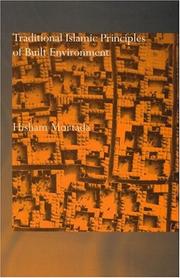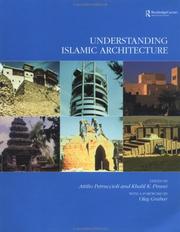| Listing 1 - 10 of 11 | << page >> |
Sort by
|
Book
ISBN: 9789004677777 9004677771 9004690182 9789004690189 Year: 2024 Publisher: Leiden ;Boston Brill
Abstract | Keywords | Export | Availability | Bookmark
 Loading...
Loading...Choose an application
- Reference Manager
- EndNote
- RefWorks (Direct export to RefWorks)
Structured as five microhistories c. 632-705, this book offers a counternarrative for the formation of Islamic architecture and the Islamic state. It adopts a novel periodization informed by moments of historical violence and anxiety around caliphal identities in flux, animating histories of the minbar, throne, and maqsura as a principal nexus for navigating this anxiety. It expands outward to re-assess the mosque and palace with a focus on the Qubbat al-Khadraʾ and the Dar al-Imara in Kufa. It culminates in a reading of the Dome of the Rock in Jerusalem as a site where eschatological anxieties and political survival converge.
Islam and architecture. --- Architecture --- Islamic architecture --- Psychological aspects. --- Political aspects. --- Historiography. --- Social aspects. --- Islam and architecture. --- Psychological aspects. --- Political aspects. --- Political aspects. .
Book
ISBN: 0755610709 0857720651 Year: 2011 Publisher: London ; New York : I.B. Tauris,
Abstract | Keywords | Export | Availability | Bookmark
 Loading...
Loading...Choose an application
- Reference Manager
- EndNote
- RefWorks (Direct export to RefWorks)
"Shi'i Islam has been the official religion of Iran from the Safavids (1501-1732) to the present day. The Shi'i world experience has provided a rich artistic tradition, encompassing painting, sculpture and the production of artefacts and performance, which has helped to embed Shi'i identity in Iran as part of its national narrative. In what areas of material culture has Iranian Shi'ism manifested itself through objects or buildings that are unique within the overall culture of Islam? To what extent is the art and architecture of Iran from the Safavid period onwards identifiably Shi'i? What does this say about the relationship of nation, state and faith in Iran? Here, leading experts trace the material heritage of Iranian Shi'ism within each of its political, religious and cultural dimensions."--Bloomsbury Publishing.
Islam and architecture. --- Islam and art. --- Islamic art and symbolism. --- Shi'ah. --- Islamic art. --- Shiah.
Book
ISBN: 9789774168550 9774168550 Year: 2018 Publisher: Cairo American University in Cairo Press
Abstract | Keywords | Export | Availability | Bookmark
 Loading...
Loading...Choose an application
- Reference Manager
- EndNote
- RefWorks (Direct export to RefWorks)
Islamic antiquities --- Islamic architecture --- Monuments --- Islam and architecture --- Cairo (Egypt) --- Buildings, structures, etc. --- Antiquities.
Book
ISBN: 9004690182 Year: 2024 Publisher: Leiden ; Boston : Brill,
Abstract | Keywords | Export | Availability | Bookmark
 Loading...
Loading...Choose an application
- Reference Manager
- EndNote
- RefWorks (Direct export to RefWorks)
Structured as five microhistories c. 632-705, this book offers a counternarrative for the formation of Islamic architecture and the Islamic state. It adopts a novel periodization informed by moments of historical violence and anxiety around caliphal identities in flux, animating histories of the minbar, throne, and maqsura as a principal nexus for navigating this anxiety. It expands outward to re-assess the mosque and palace with a focus on the Qubbat al-Khadraʾ and the Dar al-Imara in Kufa. It culminates in a reading of the Dome of the Rock in Jerusalem as a site where eschatological anxieties and political survival converge.
Architecture --- Islam and architecture. --- Islamic architecture --- Psychological aspects. --- Political aspects. --- Historiography.
Book
ISBN: 9781848851689 1848851685 Year: 2012 Publisher: London ; New York I.B. Tauris Publishers
Abstract | Keywords | Export | Availability | Bookmark
 Loading...
Loading...Choose an application
- Reference Manager
- EndNote
- RefWorks (Direct export to RefWorks)
Islam and art. --- Islam and architecture --- Islam et art --- Islam et architecture --- Islamic art --- Art islamique --- Iran --- Civilization. --- Civilisation
Book
ISBN: 8495215748 Year: 2004 Publisher: Madrid : Universidad Complutense de Madrid, Servicio de Publicaciones,
Abstract | Keywords | Export | Availability | Bookmark
 Loading...
Loading...Choose an application
- Reference Manager
- EndNote
- RefWorks (Direct export to RefWorks)
Islam and architecture --- Space (Architecture) --- Mosques --- 297.13 --- 726.2 --- Islam: cultus; liturgie --- Moskeeen. Minaretten --- 726.2 Moskeeen. Minaretten --- 297.13 Islam: cultus; liturgie --- Architecture islamique

ISBN: 1135788014 0203422686 0415515068 1280062517 9780203422687 9786610062515 661006251X 0700717005 9780700717002 9780203425046 0203425049 9781135787967 9781135788001 9781135788018 9780415515061 1135788006 Year: 2003 Publisher: London New York RoutledgeCurzon
Abstract | Keywords | Export | Availability | Bookmark
 Loading...
Loading...Choose an application
- Reference Manager
- EndNote
- RefWorks (Direct export to RefWorks)
Written with the non-Muslim reader in mind, this book analyses the principles and values established by Islamic tradition to govern the social and physical environments of Muslims.The picture of Islam that emerges from this work is of a way of life with social ideals. Relying on the Qur'an and Sunna, the basic sources of Islamic law, and using examples of the built environment of early Muslims in North Africa, the Middle East, Europe and Central Asia, the author explains how following these ideals can create an urban environment that responds to social and environmental v
Islam and architecture. --- Islamic cities and towns. --- Cities and towns, Islamic --- Muslim cities and towns --- Cities and towns --- Architecture and Islam --- Architecture --- Islam and architecture --- Islamic cities and towns --- 72.033.3 --- 72.033.3 Architectuur van de Islam; Arabie in de Middeleeuwen --- Architectuur van de Islam; Arabie in de Middeleeuwen

ISBN: 0700714383 131502876X 1136851313 0700714375 9781136851315 9781315028767 9780700714377 9780700714384 9781136851384 9781136851452 1136851380 Year: 2002 Publisher: London New York, N.Y.
Abstract | Keywords | Export | Availability | Bookmark
 Loading...
Loading...Choose an application
- Reference Manager
- EndNote
- RefWorks (Direct export to RefWorks)
The ongoing debate among practitioners and in academia about the meaning and understanding of Islamic architecture will be energized by this book. It contains essays by architects and academics from various parts of the world which clarify how the carious disciplines of the design profession can be employed to build in the spirit of Islam.
Divided into three sections the book covers:
*meaning from Faith, which draws meaning from the Islamic faith in order to propose a built environment that is universally beneficial
*analysis of History, which examines historical buildings
Islamic architecture. --- Islam and architecture. --- Architecture and Islam --- Arab architecture --- Architecture, Arab --- Architecture, Islamic --- Architecture, Moorish --- Architecture, Muslim --- Architecture, Saracenic --- Moorish architecture --- Muslim architecture --- Saracenic architecture --- Architecture --- Religious architecture
Book
ISBN: 1474416527 1474444830 1474416519 9781474416511 9781474416504 1474416500 9781474444835 147448090X Year: 2022 Publisher: Edinburgh
Abstract | Keywords | Export | Availability | Bookmark
 Loading...
Loading...Choose an application
- Reference Manager
- EndNote
- RefWorks (Direct export to RefWorks)
The Nasrid builders of the Alhambra - the best-preserved medieval Muslim palatial city - were so exacting that some of their work could not be fully explained until the invention of fractal geometry. Their design principles have been obscured, however, by the loss of all archival material. This text resolves that impasse by investigating the neglected, interdisciplinary contexts of medieval poetics and optics and through comparative study of Islamic court ceremonials.
Islam and architecture --- Architectural inscriptions --- Interior architecture --- Architectural interiors --- Architecture, Interior --- Interior space (Architecture) --- Interiors --- Space (Architecture) --- Architectural lettering --- Building inscriptions --- House inscriptions --- Inscriptions, Architectural --- Inscriptions --- Lettering --- Architecture and Islam --- Architecture --- Alhambra (Granada, Spain) --- History.
Book
ISBN: 9781138953284 9781138953291 9781315667409 Year: 2018 Publisher: London Routledge, Taylor & Francis Group
Abstract | Keywords | Export | Availability | Bookmark
 Loading...
Loading...Choose an application
- Reference Manager
- EndNote
- RefWorks (Direct export to RefWorks)
New Islamist Architecture and Urbanism claims that, in today’s world, a research agenda concerning the relation between Islam and space has to consider the role of Islamism rather than Islam in shaping – and in return being shaped by – the built environment. The book tackles this task through an analysis of the ongoing transformation of Turkey under the rule of the pro-Islamic Justice and Development Party. In this regard, it is a topical book: a rare description of a political regime's reshaping of urban and architectural forms whilst the process is alive. Defining Turkey’s transformation in the past two decades as a process of "new Islamist" nation-(re)building, the book investigates the role of the built environment in the making of an Islamist milieu. Drawing on political economy and cultural studies, it explores the prevailing primacy of nation and nationalism for new Islamism and the spatial negotiations between nation and Islam. It discusses the role of architecture in the deployment of history in the rewriting of nationhood and that of space in the expansion of Islamist social networks and cultural practices. Looking at examples of housing compounds, mosques, public spaces, and the new presidential residence, New Islamist Architecture and Urbanism scrutinizes the spatial making of new Islamism in Turkey through comparisons with relevant cases across the globe: urban renewal projects in Beirut and Amman, nativization of Soviet modernism in Baku and Astana, the presidential palaces of Ashgabat and Putrajaya, and the neo-Ottoman mosques built in diverse locations such as Tokyo and Washington DC.
Islam --- Architecture --- Economic geography --- architecture [discipline] --- urban management --- Turkey --- Islam and architecture --- Islam and state --- Urban policy --- Politics and government --- Islam et architecture --- Islam et État --- Politique urbaine --- Turquie --- Politique et gouvernement
| Listing 1 - 10 of 11 | << page >> |
Sort by
|

 Search
Search Feedback
Feedback About UniCat
About UniCat  Help
Help News
News